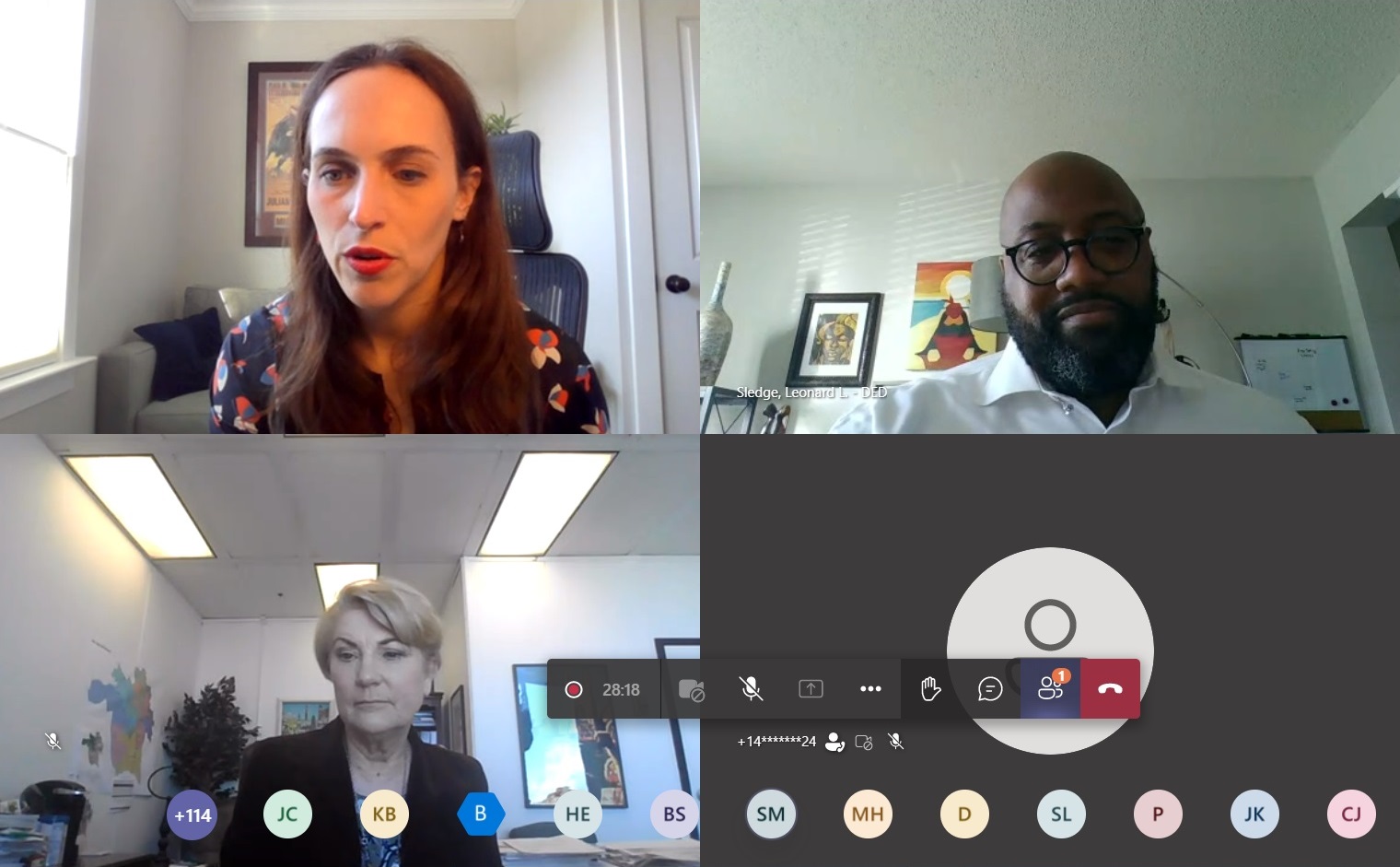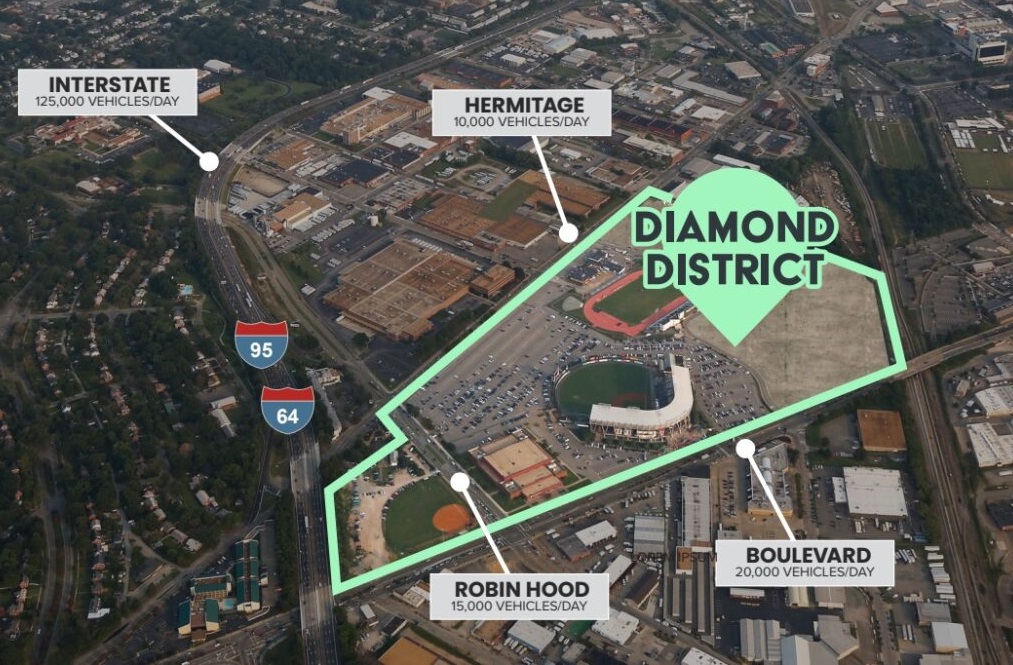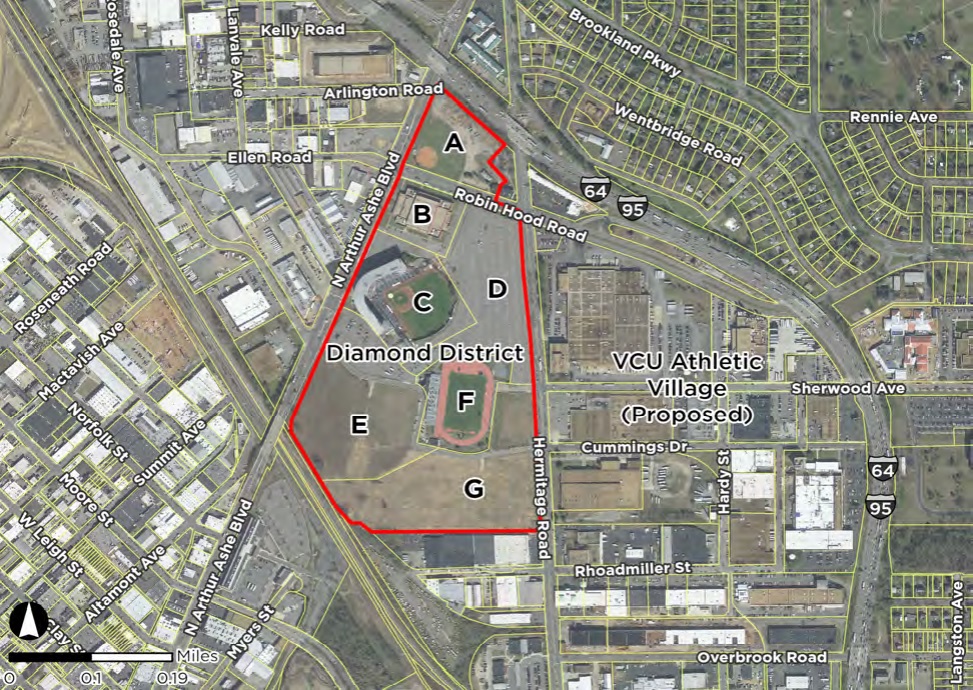
City of Richmond officials Maritza Pechin, Leonard Sledge and Sharon Ebert, clockwise from top left, during Wednesday’s virtual meeting with developers regarding Richmond’s Diamond District RFI. (Screenshot)
A first step in securing a development team to help the city build its so-called Diamond District was taken this week, with an initial question-and-answer session that drew over 100 participants.
Richmond officials held a pre-submission meeting Wednesday for prospective respondents to the city’s recently-issued request for interest (RFI) for a ballpark-anchored mixed-use development that would replace The Diamond baseball stadium and fill the roughly 60 acres of city-owned land around it.
Representatives with various firms, both local and out-of-town, tuned in and took part in the hour-long session, which was conducted online and invited questions about the project. Local names such as Hourigan, Baskervill and Spy Rock were among the firms with representatives in attendance.
The virtual meeting precedes an on-site tour to be offered next Wednesday, as well as a chance to submit written questions before submissions are due Feb. 15. A panel will evaluate the responses and compile a shortlist of firms to be invited to submit proposals in April or May, with final selections to be made in the spring or summer.
City officials leading the meeting reviewed the vision for the project as laid out in Richmond’s master plan, as well as requirements for responding and components that are desired beyond a new stadium, such as infrastructure improvements, a hotel, and office, residential and retail uses.
Sharon Ebert, the city’s deputy chief administrative officer for economic and community development, said an ideal proposal would fit within the site’s existing zoning district, called TOD-1 Transit-Oriented Nodal District, which allows for building heights of up to 12 stories. She stressed that proposals could go above and beyond that – both the conceptualized vision, and the height limit.

The area that makes up the Diamond District includes the namesake baseball stadium and nearby Sports Backers Stadium. (BizSense file images)
“We would be willing to entertain special-use permits to exceed those height limits, based on what you’re proposing,” Ebert said in the meeting.
“We really are hoping that we will get proposals that are in the spirit of making this an urban mixed-use development. I say ‘urban’ because we’re not looking for something of low-density,” she said. “We rezoned this as Transit-Oriented (Nodal) District, and that’s what we’re hoping that we get.”
Maritza Pechin, a deputy director in the city’s planning department who is leading the RFI effort, added that while conceptual plans included in the document envision components in certain places – such as the new stadium immediately south of The Diamond along Arthur Ashe Boulevard – actual locations are up for consideration too.
“You don’t have to adhere to that to the letter of what it says in the master plan. When we get to the offer stage, if development teams propose something that’s a slightly different layout but still meets the goals of the master plan, that’s fine,” Pechin said, noting that amendments could be made to the plan accordingly.
Questions posed in the meeting addressed certain aspects of the document, such as a requirement for assistance in relocating functions of the Arthur Ashe Jr. Athletic Center and Sports Backers Stadium, both of which are to be razed to make way for new development.
“We’re not asking you to rebuild the Arthur Ashe Jr. Center within the site, nor the Sports Backers facility,” Pechin clarified. “We want to be able to redevelop the whole property, and in doing so relocate those functions elsewhere.”

The 60-plus acres are bordered by Arthur Ashe Boulevard, Hermitage Road, the interstate and the railroad tracks.
Another question asked whether all of the stated components, such as the hotel or multifamily residential uses, have to be included in a proposal. Pechin said that’s the goal, given the amount of land involved.
“It’s 67 acres, it’s rather large, and if we’re trying to create a mixed-use, mixed-income entertainment destination, it may (need to) include all of those different elements,” she said.
“We are looking for it to be very mixed-use,” Ebert added, noting the site’s proximity to Scott’s Addition and other attractions. “It’s a thriving area, with a number of the museums in the city, so a hotel would be probably very beneficial and well-received.”
Who would own the new stadium was another question addressed. Where The Diamond is singularly owned by the city, Leonard Sledge, Richmond’s economic development director, said the new stadium’s ownership structure remains to be seen.
“I think we’re open,” Sledge said. “We’re just looking for solutions that ideally take the city’s financial responsibility to zero, or absolutely as close to zero as possible. From a standpoint of ownership, what’s key is the ability to have the appropriate leases in place with two primary users: the Richmond Flying Squirrels and VCU Rams.”
Whether city-owned land would be sold or leased to a developer is also to be determined. Sledge noted that any sale or lease would require seven votes of the nine-member Richmond City Council.
Noting the city’s existing agreement with the Flying Squirrels and VCU for use of The Diamond, Sledge said of the new stadium, “We don’t anticipate there being any other minor league baseball team other than the Richmond Squirrels being the tenant. All of the conversations over the years have been about the Richmond Squirrels, and no different in terms of college baseball, the VCU Rams.”
Also on the call were Todd “Parney” Parnell of the Flying Squirrels and Ed McLaughlin of VCU Athletics. Both expressed excitement about the project and appreciation for the interest shown out of the gate.
“The Flying Squirrels obviously are very focused on this project, as it is very necessary for us to get into a new facility,” Parnell said, noting new facility standards that were implemented for professional baseball last year.
“We feel like we have been part of the reason that Scott’s Addition has blossomed over the past 12 years, and we look forward to being an integral part of this transformational project that everyone on this call is interested in,” Parnell said.
Added McLaughlin: “It’s a great partnership right now, and we’re looking forward to this project very much, in working with not only whoever the successful developer is but with our partners with the Squirrels and the city, to make sure this area of land absolutely takes off and is transformational for the city.”
The Flying Squirrels – the Double-A affiliate of the San Francisco Giants – has been promised a new ballpark since its arrival in 2010. It would need a new stadium by the 2025 season to be compliant with the new facility standards. The RFI calls for the new, 10,000-capacity stadium to be built first to meet that deadline.
A participant in Wednesday’s meeting asked if consideration had been given to renovating The Diamond to meet the new standards, which put the 1980s-era stadium out of compliance on issues such as lack of dressing facilities for female staff and training and weight room space. Pechin replied that it has been considered and deemed “physically impossible and, therefore, also cost-ineffective.”
“There are certain requirements that happen behind the scenes – locker rooms, provisions for female staff – that you physically cannot do within the space,” Pechin said. “And if you really were to try to do it, it would cost a lot of money. It’s something we have explored, but we’re not continuing that exploration.”

City of Richmond officials Maritza Pechin, Leonard Sledge and Sharon Ebert, clockwise from top left, during Wednesday’s virtual meeting with developers regarding Richmond’s Diamond District RFI. (Screenshot)
A first step in securing a development team to help the city build its so-called Diamond District was taken this week, with an initial question-and-answer session that drew over 100 participants.
Richmond officials held a pre-submission meeting Wednesday for prospective respondents to the city’s recently-issued request for interest (RFI) for a ballpark-anchored mixed-use development that would replace The Diamond baseball stadium and fill the roughly 60 acres of city-owned land around it.
Representatives with various firms, both local and out-of-town, tuned in and took part in the hour-long session, which was conducted online and invited questions about the project. Local names such as Hourigan, Baskervill and Spy Rock were among the firms with representatives in attendance.
The virtual meeting precedes an on-site tour to be offered next Wednesday, as well as a chance to submit written questions before submissions are due Feb. 15. A panel will evaluate the responses and compile a shortlist of firms to be invited to submit proposals in April or May, with final selections to be made in the spring or summer.
City officials leading the meeting reviewed the vision for the project as laid out in Richmond’s master plan, as well as requirements for responding and components that are desired beyond a new stadium, such as infrastructure improvements, a hotel, and office, residential and retail uses.
Sharon Ebert, the city’s deputy chief administrative officer for economic and community development, said an ideal proposal would fit within the site’s existing zoning district, called TOD-1 Transit-Oriented Nodal District, which allows for building heights of up to 12 stories. She stressed that proposals could go above and beyond that – both the conceptualized vision, and the height limit.

The area that makes up the Diamond District includes the namesake baseball stadium and nearby Sports Backers Stadium. (BizSense file images)
“We would be willing to entertain special-use permits to exceed those height limits, based on what you’re proposing,” Ebert said in the meeting.
“We really are hoping that we will get proposals that are in the spirit of making this an urban mixed-use development. I say ‘urban’ because we’re not looking for something of low-density,” she said. “We rezoned this as Transit-Oriented (Nodal) District, and that’s what we’re hoping that we get.”
Maritza Pechin, a deputy director in the city’s planning department who is leading the RFI effort, added that while conceptual plans included in the document envision components in certain places – such as the new stadium immediately south of The Diamond along Arthur Ashe Boulevard – actual locations are up for consideration too.
“You don’t have to adhere to that to the letter of what it says in the master plan. When we get to the offer stage, if development teams propose something that’s a slightly different layout but still meets the goals of the master plan, that’s fine,” Pechin said, noting that amendments could be made to the plan accordingly.
Questions posed in the meeting addressed certain aspects of the document, such as a requirement for assistance in relocating functions of the Arthur Ashe Jr. Athletic Center and Sports Backers Stadium, both of which are to be razed to make way for new development.
“We’re not asking you to rebuild the Arthur Ashe Jr. Center within the site, nor the Sports Backers facility,” Pechin clarified. “We want to be able to redevelop the whole property, and in doing so relocate those functions elsewhere.”

The 60-plus acres are bordered by Arthur Ashe Boulevard, Hermitage Road, the interstate and the railroad tracks.
Another question asked whether all of the stated components, such as the hotel or multifamily residential uses, have to be included in a proposal. Pechin said that’s the goal, given the amount of land involved.
“It’s 67 acres, it’s rather large, and if we’re trying to create a mixed-use, mixed-income entertainment destination, it may (need to) include all of those different elements,” she said.
“We are looking for it to be very mixed-use,” Ebert added, noting the site’s proximity to Scott’s Addition and other attractions. “It’s a thriving area, with a number of the museums in the city, so a hotel would be probably very beneficial and well-received.”
Who would own the new stadium was another question addressed. Where The Diamond is singularly owned by the city, Leonard Sledge, Richmond’s economic development director, said the new stadium’s ownership structure remains to be seen.
“I think we’re open,” Sledge said. “We’re just looking for solutions that ideally take the city’s financial responsibility to zero, or absolutely as close to zero as possible. From a standpoint of ownership, what’s key is the ability to have the appropriate leases in place with two primary users: the Richmond Flying Squirrels and VCU Rams.”
Whether city-owned land would be sold or leased to a developer is also to be determined. Sledge noted that any sale or lease would require seven votes of the nine-member Richmond City Council.
Noting the city’s existing agreement with the Flying Squirrels and VCU for use of The Diamond, Sledge said of the new stadium, “We don’t anticipate there being any other minor league baseball team other than the Richmond Squirrels being the tenant. All of the conversations over the years have been about the Richmond Squirrels, and no different in terms of college baseball, the VCU Rams.”
Also on the call were Todd “Parney” Parnell of the Flying Squirrels and Ed McLaughlin of VCU Athletics. Both expressed excitement about the project and appreciation for the interest shown out of the gate.
“The Flying Squirrels obviously are very focused on this project, as it is very necessary for us to get into a new facility,” Parnell said, noting new facility standards that were implemented for professional baseball last year.
“We feel like we have been part of the reason that Scott’s Addition has blossomed over the past 12 years, and we look forward to being an integral part of this transformational project that everyone on this call is interested in,” Parnell said.
Added McLaughlin: “It’s a great partnership right now, and we’re looking forward to this project very much, in working with not only whoever the successful developer is but with our partners with the Squirrels and the city, to make sure this area of land absolutely takes off and is transformational for the city.”
The Flying Squirrels – the Double-A affiliate of the San Francisco Giants – has been promised a new ballpark since its arrival in 2010. It would need a new stadium by the 2025 season to be compliant with the new facility standards. The RFI calls for the new, 10,000-capacity stadium to be built first to meet that deadline.
A participant in Wednesday’s meeting asked if consideration had been given to renovating The Diamond to meet the new standards, which put the 1980s-era stadium out of compliance on issues such as lack of dressing facilities for female staff and training and weight room space. Pechin replied that it has been considered and deemed “physically impossible and, therefore, also cost-ineffective.”
“There are certain requirements that happen behind the scenes – locker rooms, provisions for female staff – that you physically cannot do within the space,” Pechin said. “And if you really were to try to do it, it would cost a lot of money. It’s something we have explored, but we’re not continuing that exploration.”




Please put down your bets if you think this process with be smooth and the City will meet its own deadlines….what no takers. At least they have until the April 2025 to get the new stadium ready for use. I mean that gives the City about 1 year to complete the final RFP after the RFI and the future developers 2 years to build it out. What could go wrong?